Jennifer McCurdy, a ceramic artist from Martha’s Vineyard, Massachusetts, draws on the forms and shapes of nature, translating spirals and fractals, seaweed and flowers into vessels that evoke their source in such a way that the viewer comes away feeling as if they have seen into the heart of something beautiful and living.
McCurdy's finished vessels have an organic look to them, like flowers or leaves, or perhaps seaweed, but aren't representational. “I would be defeated if I tried to copy nature’s patterns,” she says. “I just try to think the way nature thinks and have the work flow from there but, because of the repetition of pattern in my work, I hope that my pieces look more grown than made.”
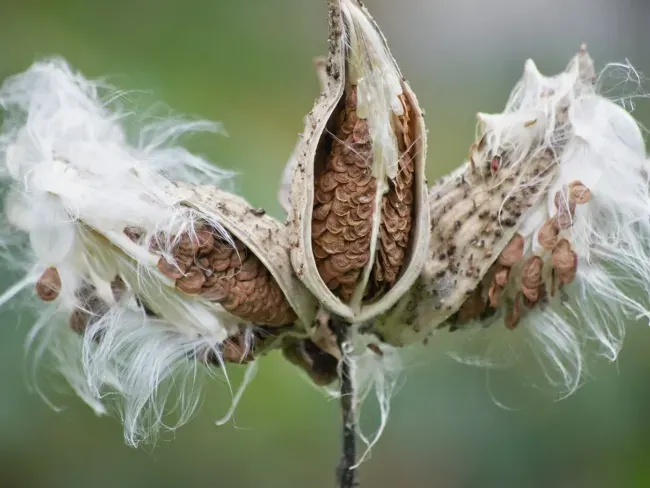
As she says, "Emotion fills me when I see perfect forms in nature, from the cracked conch shell on the beach revealing its perfect spiral, to the milkweed pod burst in the field, its brilliant airborne seeds streaming into the sunlight. The ordered symmetry and asymmetry of nature's forms reveal the growth of life, the movement of life."
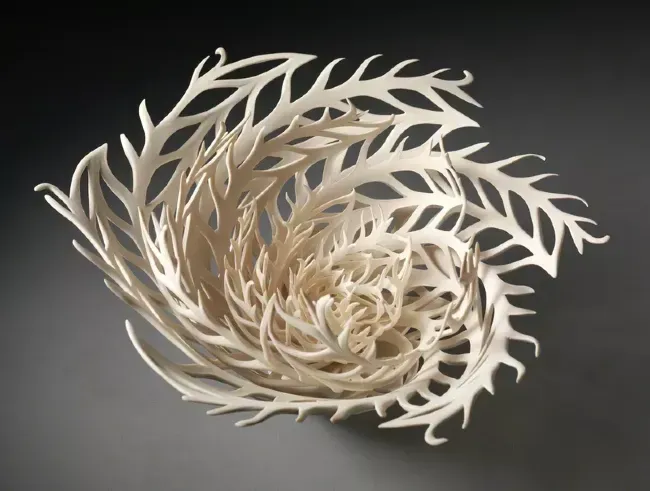
You can see movement reflected in the work of McCurdy, as her forms of clay twist and fold, swirl and bend. There is a sense of flux, a sense of life that is developing and unfurling. Although her pieces are solid and stable when completed, they do not feel static as you look at them. This sense of movement is also inherent in each step of the creative work she does to create these vessels.
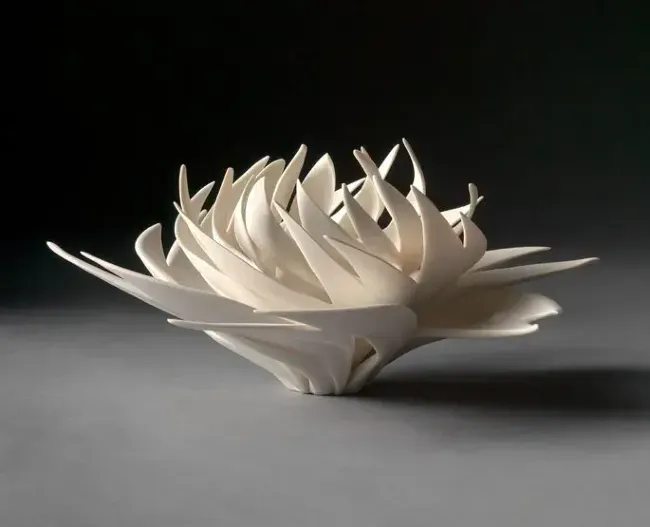
In addition to the inspiration that is needed to envision the work she creates, it has taken years of experience to build the skill that allows McCurdy to manipulate the clay as she does.
“People always ask me how long it takes to create one of my pieces,” Jennifer says. “I tell them about eight hours and 30 years.”
McCurdy uses porcelain in her work which, because it absorbs water more quickly than other clays before being fired and is flimsier before it dries, it is difficult to throw on a potter's wheel. After the beginning of a throw, when she uses some water, McCurdy then uses "dry throwing," in which she shapes the clay using flexible metal ribs instead of her fingers.
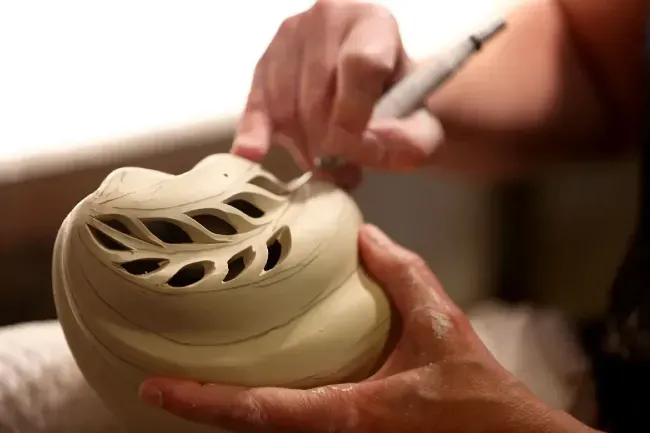
After she has formed the basic structure of the vessel on the potter's wheel, she moves quickly to carve it while it is still soft and leather-like. This is a difficult technique since each vessel must contain just the right amount of moisture and be completed quickly before it dries.
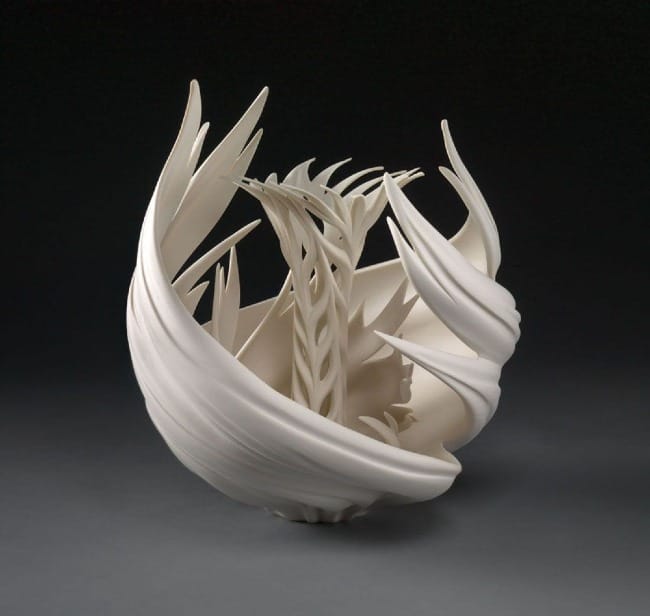
Even after it has been formed and is ready for firing, the piece is still in a state of flux. When the clay is still moist, but after the artist has cut and twisted the piece, she often will hang it upside down so that the clay is stretched out and formed by the pull of gravity upon it. This gives an organic flow to the piece—elongating it and causing what will be its top to open up rather than having it settle or slump in upon itself as it would if it were placed right side up on its base. As a result, the pieces she creates using this method have tendril-like arms and a feeling of space and openness within their center.
Porcelain is fired at a higher temperature than other clay (between 2,200°F and 2,600°F rather than between 2124℉ and 2264°F) and once it has been fired, it becomes a hard, translucent substance.
“I use a translucent porcelain body because it has a beautiful surface, and it conveys the qualities of light and shadow that I wish to express,” said McCurdy in her artist statement. “After throwing my vessel on the potter’s wheel, I alter the form to set up a movement of soft shadow. When the porcelain is leather hard, I carve patterns to add energy and counterpoint. I fire my work to cone 10, where the porcelain becomes non-porous and translucent.”
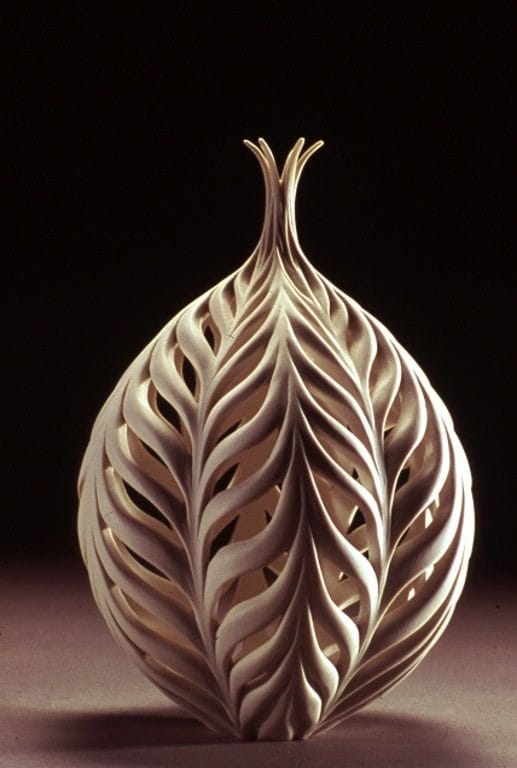
Almost every piece Jennifer McCurdy creates is crafted of unglazed white porcelain. Put into the kiln as gray clay, the high heat transforms it into thin, translucent white porcelain. By holding it up to the light, you can see the shadow of your finger through it. Because it is non-porous, it will hold water without being glazed, which for McCurdy is important.
"I’m working with light and shadow and the various qualities of light such as translucency, hard shadow, and soft shadow. A number of years ago I found that glazing detracted from this.”
Motion, light and space are central to McCurdy.
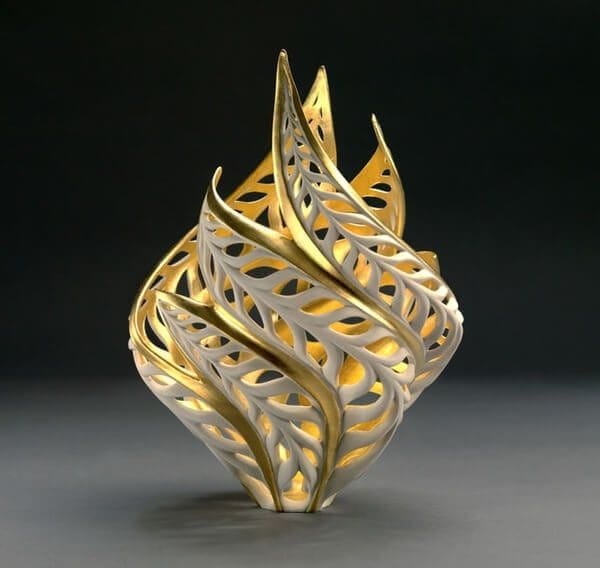
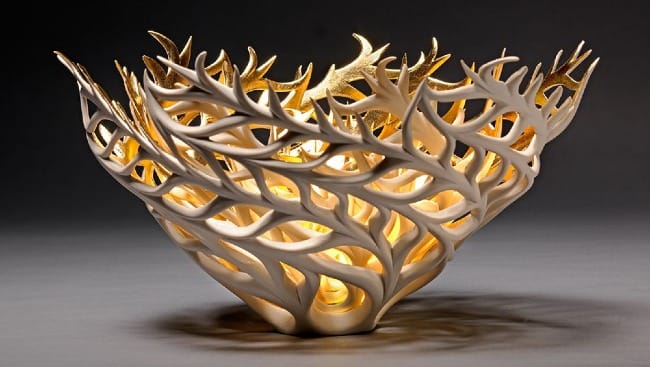
Left: Gilded Butterfly Vessel; Right: Gilded Coral Nest, Jennifer McCurdy, gilded by Tom McCurdy
Sometimes, McCurdy adds 23-carat gold leaf detail gold tinting to the inside of her pieces. Her husband, Tom, a former sign painter, partners with her on these pieces, applying the gold tinting to the inside of the pieces, where it catches the light and holds it, creating a sense of light emanating from within the center of the piece.
When presented with opportunities to learn and stretch her skills, McCurdy has taken advantage of those chances. In 2009, a husband and wife who admired her work and collected art, offered her a stipend in exchange for pieces of original art. The stipend was given to allow her to experiment with her craft without the pressure of having to make marketable items while she was experimenting with technique and form. This arrangement gave her a freedom to freely try things she might not have tried otherwise and gave her sponsors original artwork created with the new techniques she was developing.
In 2020, when the pandemic cancelled exhibitions around the world, McCurdy took advantage of the pause to reevaluate her own work, both the philosophical connection of her work to nature and the craft she used, exploring new forms and testing out different carving techniques. “I think the direction of my work did not change, but it gained clarity from focusing on the space between and around each form,” she says.
As McCurdy says, she pushes her craft to the limit, trying to find how close she can come to the edge without falling off.
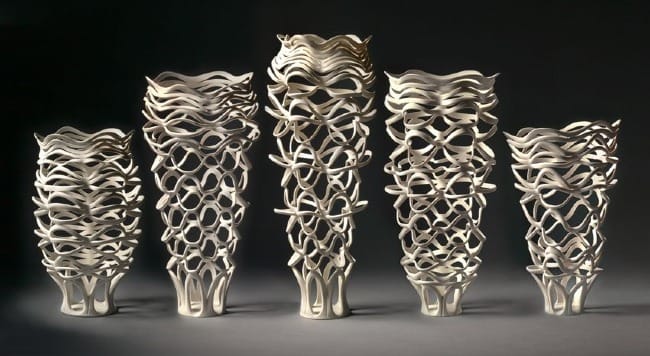
“How thin can the high fire porcelain be before it collapses in the fire?” or “How much can it be cut away and still maintain structural integrity?”
Being brave enough to assess or reassess where we are, and to be able to move outside the places we have become used to into new places where we might learn new things, or possibly fail, are invaluable gifts to the creativity within us and our growth as individuals and even communities. When we have or make space to breathe and explore, amazing new things can emerge.
Reflection Questions: What skills have you invested deeply in learning or what skills do you want to deeply invest in learning? Are there tasks that or skills that will take you a lifetime to learn that you consider worth the time it would take to learn them? Are there things you see in nature that inform the work you do?
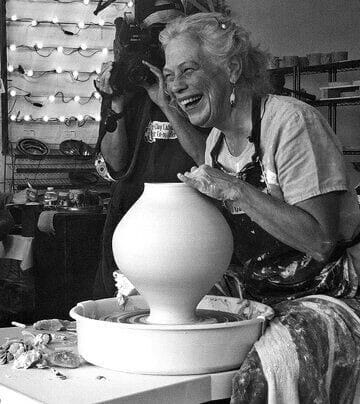
You can find more of the artist's work on her website. If you would like to see the process she uses to mold her pieces, check out this YouTube video.
Feel free to comment below or contact me directly at info@circlewood.online.
Louise
